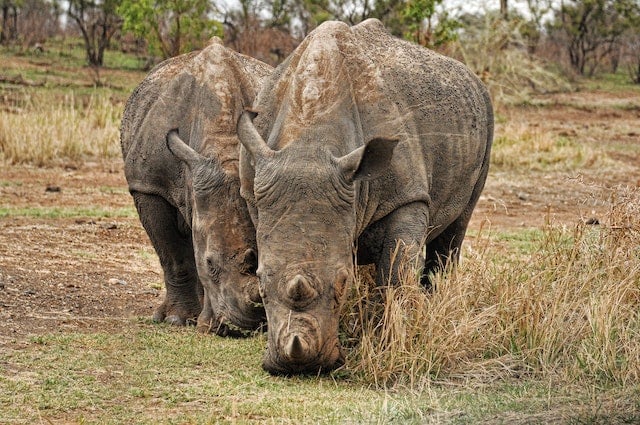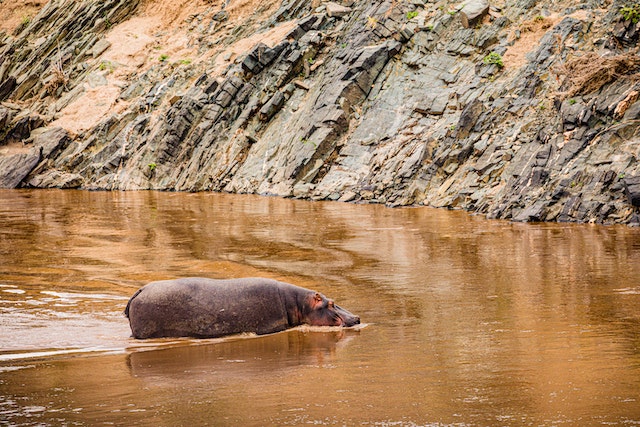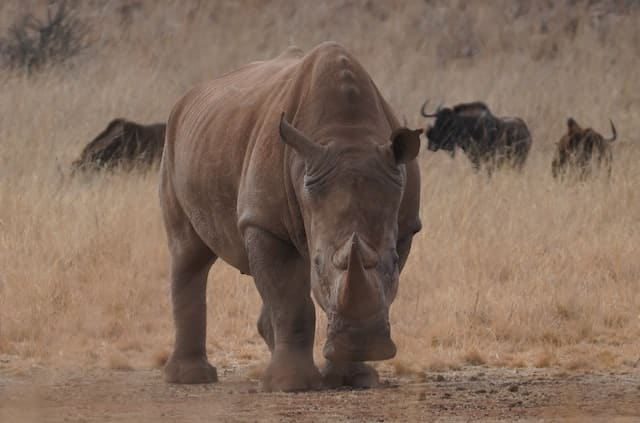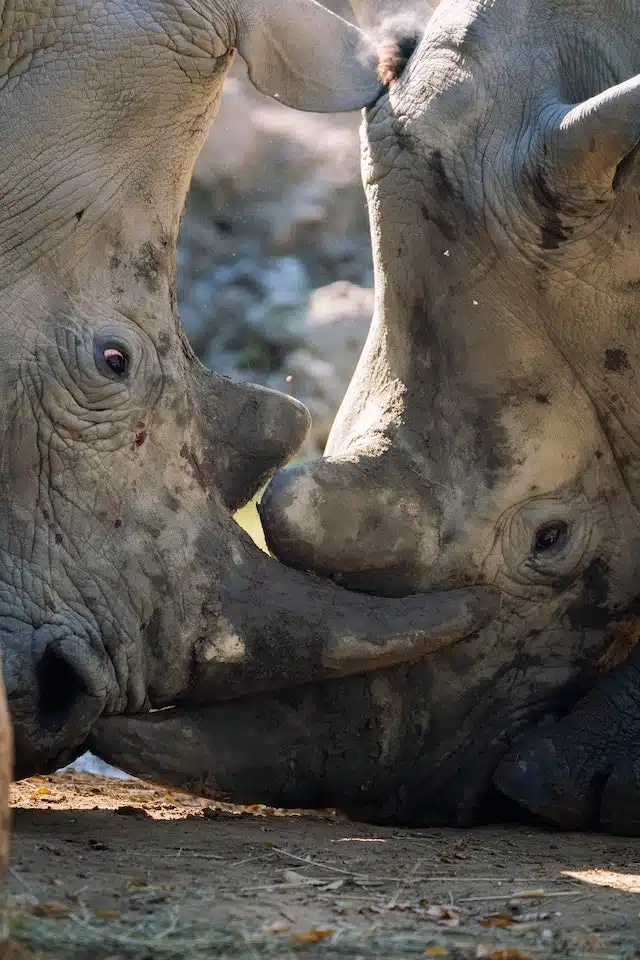It’s a battle of the giants, and who doesn’t love a good showdown? On one side, we have the powerful rhinoceros, and on the other, the hefty hippopotamus. There’s nothing quite like a Rhino vs. Hippo head-to-head competition in a size, strength, agility, and speed battle. But which one would come out on top? It’s time to settle this debate.
To answer this question, we must understand both animals‘ strengths and weaknesses. Let’s take a closer look at each one
Rhino vs. Hippo: Overview
The rhino and the hippopotamus are two of the most formidable and interesting animals in the wild. Both of these creatures have been around for millions of years and have evolved to become powerful and adaptable creatures, and they have unique characteristics that make them stand out from their peers.

The rhinoceros is a large, herbivorous mammal native to Africa and Asia. It is one of the five existing species of rhinoceros, the others being the White Rhino, the Indian Rhino, the Javan Rhino, and the Sumatran Rhino.
Rhinos are easily recognizable by their large size and distinctive horn, which they use for territorial posturing and defense. All rhinos have thick skin covered in thick fur, with one or two horns on the front of their face.
The hippopotamus is a large, semi-aquatic mammal found in sub-Saharan Africa. It is the third-largest land mammal in the world and the heaviest existing even-toed ungulate.
There are two species of hippo, the common hippo, and the pygmy hippo. Both species have thick skin covered in short fur, with a large head and mouth.
Hippos are recognizable by their large size, barrel-shaped bodies, and thick, gray skin. They also have a set of large, sharp teeth that they use for defense and foraging.
Rhino vs. Hippo: Physical Characteristics
The rhino is a large mammal, typically weighing between 3,000 to 7,000 lbs. Its body is heavily built, with thick skin and a short, stocky neck. It has a large head and a distinctive horn, which is made up of keratin. Its eyes are small, and its ears are tipped with black hair. Its legs are short and stocky, and its feet are large and rounded.
The most notable feature of the rhinoceros morphology is perhaps its keratin horns, made from subcutaneous tissues. Rhino horn is widely sought after by poachers, and it’s one of the reasons why the specie is declining in population.
The hippo is also a large mammal, typically weighing between 2,000 and 5,000 pounds. Its body is barrel-shaped, with a large head, short neck, and wide muzzle. Its skin is thick and gray, and its eyes and ears are small. It has a set of large, sharp teeth that it uses for defense and foraging.

The hippo’s legs are short and stocky, and its feet are webbed for easy movement on land and water. Surprisingly though, the hippo is not a great swimmer. They barely move in shallow waters but bounce off the riverbed to come up for air in deep waters.
Although the Rhino is the larger beast by mass, the hippo and rhino can grow to an impressive 5’2” at the shoulder. However, in a length-wise Rhino vs. Hippo matchup, the hippo marginally edges out the rhino. The hippo’s barrel-shaped body means they can grow up to 16ft when fully grown, while the rhino maxes out at 13ft.
Rhino vs. Hippo: Strength and Agility
It’s no secret that rhinos and hippos are both incredibly strong animals. However, they have different kinds of strengths. Rhinos have immense strength in their legs and shoulders, which they use to charge and trample their opponents.
The apt positioning of rhino horns can make an encounter with them lethal. They are also incredibly resilient and can withstand a great deal of punishment before succumbing to injuries.
Hippos, on the other hand, have incredible jaw strength. They have the strongest bite force of any mammal, biting with a force of up to 1800 pounds per square inch. This makes them incredibly formidable opponents in any encounter. They also have great endurance and can move in water for long periods without tiring.
Both animals have the tools to inflict maximum damage in a Rhino vs. Hippo battle, so the jury is still out on this one.
Rhino vs. Hippo: Speed and Endurance
The rhino has the upper hand when comparing the Rhino vs. Hippo by speed and agility.
Rhinos have incredibly powerful muscles, which means they can lift up to four times their own body weight. They also have the power to charge at speeds up to 35mph and can turn on a dime, making them difficult to outrun or outmaneuver. They are also agile climbers and can scale steep slopes with ease.
Although Hippos are not fast runners, they are no slouches in the running department either. They can sprint up to 15 mph, which is impressive for their size. However, they can move doubly fast when in water, as water makes them buoyant. They are incredibly strong animals and agile enough to lift up to two times their body weight. Yet, their incredibly short limbs make them poor climbers.
Social Behavior
Rhinos and Hippos are fairly social animals. Though rhinos are solitary by nature, they may live in small family groups and are fiercely loyal to their herd members. They also show a great deal of affection towards each other, grooming and nuzzling one another. Still, they are territorial and will fiercely defend their territory against intruders.

In a sense, hippos are more social than rhinos as they live in larger groups with loose hierarchies. However, they are not as affectionate toward herd members as rhinos and tend to show territorial aggression towards each other. Yet, they tend to show a relaxed attitude towards outsiders and are more tolerant of other species in their vicinity.
Mating Behavior
Mating behaviors between the rhino and hippo couldn’t be more different. Rhinos, which are social animals, will gather in groups for mating. The male rhino will then try to attract a mate by displaying his horns and showing off his strength. The female will usually choose a mate that is the strongest and most dominant.
Hippos, on the other hand, prefer to mate in isolation. The males will defend their territory, using grunts and vocalizations to ward off any intruders. Female hippos in his territory will only mate with one male and will remain loyal to him for the entirety of their lifetime.
Rhino vs. Hippo: Diet and Feeding Behavior
The distinction is quite clear when analyzing Rhinos vs. Hippos by feeding behavior. Rhinos are strictly herbivorous animals, meaning they feed on grass, leaves, and other plant matter. They prefer to graze on grasses and other low-lying vegetation.
Contrastingly, Hippos are omnivores, feeding on both plants and animals. However, most of their nutrition comes from plants, and they only feed on fish and carrion if the opportunity arises. Because hippos are sensitive to heat from sunlight, they are nocturnal feeders. They emerge from the water just after dusk and can eat up to 80kg of food before dawn when they go back into the water.
Rhinos are browsers and prefer to eat from low-growing shrubs. Hippos are grazers and spend most of their time grazing on grasses. However, even though Hippos may have a more varied diet than rhinos, they are not capable of digesting a wide variety of plants like them.
Rhino vs. Hippo: Natural Habitat
Rhinos and hippos have very different natural habitats. Rhinos are found in dry savannahs, grasslands, and woodlands in Africa and Asia. They prefer areas with plenty of cover, such as dense scrub or tall grass.

Conversely, hippos are found in rivers, lakes, and swamps in sub-Saharan Africa. They prefer shallow, slow-moving water and muddy banks, which provide them with plenty of food and protection from predators. Here are the best places to see Hippos in the wild.
Historical Conflict
Throughout history, rhinos and hippos have been in conflict with each other. In the past, rhinos and hippos have been known to fight over food and territory. Rhinos have also been known to attack hippos in order to protect their young.
However, these conflicts are rare, and there have been no recorded instances of a rhino killing a hippo in the wild. Most of these conflicts are likely avoided due to the animals’ different habitats.
Rhino vs. Hippo: Conservation Threats and Specie Population
Threats to survival is not a Rhino vs. Hippo showdown category many will find fun. However, wouldn’t it be fun to know what any possible outcome in a fight means to the whole species?
Rhinos and hippos have long been hunted for their horns and tusks, which are used in various traditional medicines and cultural practices. Unfortunately, this practice has become increasingly profitable in recent years, leading to a surge in the poaching of these animals. The illegal wildlife trade has become an international phenomenon, with a wide variety of products made from rhino and hippo parts being sold online and on the black market. You can help out and adopt a rhino here.
Habitat destruction also poses a major threat to these species. As human populations expand into wild areas, we take over the land these animals need to survive. Human development projects such as logging, mining, and road construction can fragment and degrade vital habitats, leaving rhinos and hippos with fewer places to live.
Climate change is also having a significant impact on rhinos and hippos. Warming temperatures can cause changes in precipitation patterns and the spread of disease, both of which can harm these animals. Additionally, rising sea levels can inundate critical habitats, making it difficult for these species to find suitable living spaces.
Finally, human-wildlife conflict is another major threat to rhinos and hippos. As humans encroach on their habitats, these animals often find themselves competing for resources with people. In some cases, this can lead to conflict, resulting in injury or death for the animals involved.
Population
Regarding population numbers, rhinos and hippos are on opposite ends of the spectrum. Rhinos are an endangered species, with the majority living in East and Southern Africa. The International Union for Conservation of Nature estimates that the global population of rhinos is fewer than 30,000 individuals. This number continues to decline due to poaching, habitat loss, and human-wildlife conflict.
On the other hand, hippos have a much larger population, with an estimated 125,000-150,000 individuals across Africa. Though their numbers have decreased due to poaching and human encroachment on their habitats, their population remains fairly stable.
The stark contrast between the two species highlights the importance of conservation efforts and taking steps to ensure that endangered species like rhinos can survive and thrive in our changing world.
Rhino vs. Hippo: Who Would Win?
So, who would come out on top in a fight between a rhino and a hippo? The short answer is – it depends. If the fight takes place in an open area, then the rhino would likely win due to its greater speed and agility. However, if the fight takes place in water, then the hippo would likely have the advantage due to its greater strength and jaw power.

Both animals are incredibly powerful and formidable opponents, and the fight’s outcome depends on the situation and terrain. In an open terrain on land, the rhino will come out as the winner as it can gain a lot of speed and hit the hippo with a bigger force. In water, the hippo might be able to tackle the rhino and win through its bite force.
Conclusion
A showdown between the rhino and the hippo will surely be a hotly debated topic. It really depends on where the fight takes place in order to say who would come out on top. Nevertheless, a fight between these two powerful animals would surely be an epic show.
So, if you ever find yourself looking at a rhino vs. Hippo fight, it’s best to take a step back and let nature take its course. After all, who are we to decide the outcome of such a monumental encounter?
- Top 5 Rarest Animals in the World - April 15, 2024
- Mongoose Meets One Of The Deadliest Snakes Alive - April 8, 2024
- Watch: Komodo Dragon Swallows Baby Goat In Seconds - March 28, 2024


